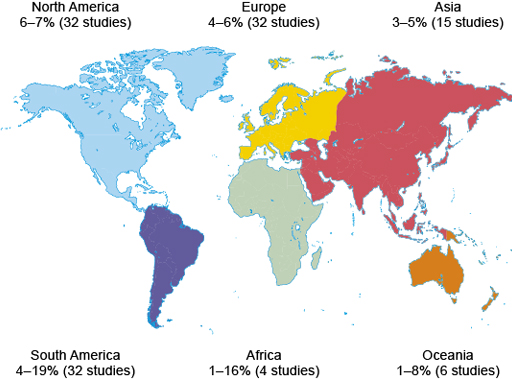1.1 Characteristics and prevalence of ADHD
Atypical development during ADHD results in persistent and developmentally inappropriate levels of:
- inattention
- hyperactivity
- impulsivity.
Of course, individuals without ADHD can still be inattentive, hyperactive and impulsive to some degree but with ADHD, as with other neurodevelopmental conditions such as autism, these behaviours are persistent and represent a divergence from typical cognitive milestones.
Prevalence data (the number of new and continuing cases) indicate that ADHD is the most common of the neurodevelopmental conditions (Hansen et al., 2018).
Estimates of the worldwide prevalence of ADHD are around 6 in 100 children and adolescents and 3 in 100 adults (Spencer et al., 2002; Moffitt et al., 2015).
-
What do you notice about prevalence rates in the two age groups?
-
Around twice as many children and adolescents have ADHD compared with adults.
This difference in prevalence was initially thought to arise because some children with ADHD simply grew out of their condition. However, it has now been suggested that the two cohorts (i.e. children/adolescents versus adults) may not be the same – so adults with ADHD are not simply children and adolescents with the condition who grow up (Moffitt et al., 2015). At the time of writing this course in 2019-2020, research into ADHD in adults is still in its relatively early stages and therefore it is difficult to draw firm conclusions about this cohort. However, for children and adolescents, much more extensive research has been carried out. The data suggest that prevalence rates of the condition for this age group vary across the world as shown in Figure 1.
-
From Figure 1, what do you notice about the number of studies carried out in the different continents?
-
There is quite a large difference in the number of studies carried out: North America and Europe, for example, have 32 studies each, while Africa only has 4 studies.
-
What impact could this difference have on the interpretation of these data?
-
In areas with fewer studies, the prevalence data may not have been replicated. This does not necessarily mean the data are incorrect, but it does mean that they may be deemed less reliable.
Of course, the number of studies is not the only consideration. The size of the study is also important. A large study with 10 000 participants from multiple areas in a country is likely to be more reliable than a study with 100 participants from a single location. There could be practical reasons for the differences in the number or size of studies, such as the amount of funding available for research.
Even where data are available from several countries, as is the case for ADHD, worldwide prevalence rates should be interpreted with caution.
-
Why should these data be viewed cautiously (hint: think about the possible effects of available health resources and culture)?
-
Some areas of the world, especially low- and middle-income countries (LMIC) have little or no access to diagnostic services, meaning there is no real basis on which to estimate prevalence. There may also be stigma associated with a condition, or different cultural expectations about the ‘typical behaviour’ in different areas around the world that have an impact on prevalence estimates.
The data in Figure 1 hint at a non-standard set of diagnostic criteria being employed in some regions.
-
Based on the data in the figure, which countries may not be adopting a standard set of diagnostic criteria?
-
There is a greater range in prevalence estimates in the studies conducted in Africa and South America, compared with North America, Europe and Asia. This greater range could indicate a lack of standardised diagnostic criteria.
This issue is not specific to neurodevelopmental conditions; it can be found for a range of mental- and physical-health conditions and therefore caution is needed when considering worldwide prevalence data for any condition.
In children and adolescents, the majority of those diagnosed with ADHD are male, but in adults, both genders are diagnosed with equal frequency (Moffitt et al., 2015). Although the experience of ADHD in adults is extremely interesting, research is in its early stages, therefore the rest of this course will focus on ADHD in children and adolescents.
When trying to understand any condition a good place to start is the experience of the individuals, and those close to them.

